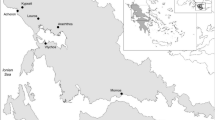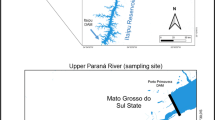Abstract
Diplostomum sp. is a trematode parasite that infects aquatic snails, e.g. Lymnaea stagnalis (Gastropoda: Lymnaeidae), fish, and fish-eating birds. Ponds and lakes (n = 28) located in Finland between latitudes 61°45′N and 65°30′N were sampled for L. stagnalis, the first intermediate host for Diplostomum sp. L. stagnalis were found in 22 sites out of 28, and Diplostomum sp. in 10 of the 22 snail populations. Among the L. stagnalis populations that were infected by Diplostomum sp., the mean prevalence was 12.8%. Diplostomum sp. occurred in only one out of the seven L. stagnalis populations in four large lakes, but in 9 out of the 16 L. stagnalis populations in small lakes. In the pooled data, a positive correlation (r s = 0.427; P = 0.047; n = 22) between L. stagnalis density and Diplostomum sp. prevalence was found. The results suggest that Diplostomum sp. is fairly common in L. stagnalis populations in small lakes but rare in large lakes. Furthermore, although trematode parasites, in general, should have a negative effect on snail population density, the study indicates that the relationship between host density and parasite prevalence may greatly differ for individual trematode species, such as Diplostomum sp.


Similar content being viewed by others
Explore related subjects
Discover the latest articles and news from researchers in related subjects, suggested using machine learning.References
Arneberg P (2001) An ecological law and its macroecological consequences as revealed by studies of relationships between host densities and parasite prevalence. Ecography 24:352–358. doi:10.1034/j.1600-0587.2001.240313.x
Arneberg P, Skorping A, Grenfell B, Read AF (1998) Host densities as determinants of abundance in parasite communities. Proc R Soc Lond B Biol Sci 265:1283–1289. doi:10.1098/rspb.1998.0431
Bernot RJ (2003) Trematode infection alters the antipredator behaviour of a pulmonate snail. J N Am Benthol Soc 22:241–248. doi:10.2307/1467995
Brown KM, Leathers BK, Minchella DJ (1988) Trematode prevalence and the population dynamics of freshwater pond snails. Am Midl Nat 120:289–301. doi:10.2307/2426001
Chappell LH, Hardie LJ, Secombes CJ (1994) Diplostomiasis: the disease and host parasite interactions. In: Pike AW, Lewis JW (eds) Parasitic diseases of fish. Samara Publishing Ltd., Otley, West Yorkshire
Dillon RT Jr (2000) The ecology of freshwater molluscs. Cambridge University Press, Cambridge
Faltynkova A (2005) Larval trematodes (Digenea) in molluscs from small water bodies near Ceske Budejovice, Czech Republic. Acta Parasitol 50:49–55
Faltynkova A, Haas W (2006) Larval trematodes in freshwater molluscs from the Elbe to Danube rivers (Southeast Germany): before and today. Parasitol Res 99:572–582. doi:10.1007/s00436-006-0197-9
Faltynkova A, Niewiadomska K, Santos MJ, Valtonen ET (2007) Furcocercous cercariae (Trematoda) from freshwater snails in Central Finland. Acta Parasitol 52:310–317. doi:10.2478/s11686-007-0050-z
Hechinger RF, Lafferty KD (2005) Host diversity begets parasite diversity: bird final hosts and trematodes in snail intermediate hosts. Proc R Soc Lond B Biol Sci 272:1059–1066. doi:10.1098/rspb.2005.3070
Heino J, Muotka T (2005) Highly nested snail and clam assemblages in boreal lake littorals: roles of isolation, area, and habitat suitability. Ecoscience 12:141–146. doi:10.2980/i1195-6860-12-1-141.1
Heino J, Muotka T (2006) Landscape position, local environmental factors, and the structure of Molluscan assemblages of lakes. Landscape Ecol 21:499–507. doi:10.1007/s10980-005-2377-x
Höglund J, Thulin J (1992) Identification of Diplostomum spp. in the retina of perch Perca fluviatilis and the lens of roach Rutilus rutilus from the Baltic Sea—an experimental study. Syst Parasitol 21:1–19
Karvonen A, Kirsi S, Hudson PJ, Valtonen ET (2004) Patterns of cercarial production from Diplostomum spathaceum: terminal investment or bet hedging? Parasitology 129:87–92. doi:10.1017/S0031182004005281
Karvonen A, Savolainen M, Seppälä O, Valtonen ET (2006a) Dynamics of Diplostomum spathaceum in snail hosts at a fish farm. Parasitol Res 99:341–345. doi:10.1007/s00436-006-0137-8
Karvonen A, Terho P, Seppälä O, Jokela J, Valtonen ET (2006b) Ecological divergence of closely related Diplostomum (Trematoda) parasites. Parasitology 133:229–235. doi:10.1017/S0031182006000242
Kuris AM, Lafferty KD (1994) Community structure: larval trematodes in snail hosts. Annu Rev Ecol Syst 25:189–217. doi:10.1146/annurev.es.25.110194.001201
Lafferty KD (1993) Effects of parasitic castration on growth, reproduction and population dynamics of the marine snail Cerithidea californica. Mar Ecol Prog Ser 96:229–237. doi:10.3354/meps096229
Levri EP (1999) Parasite-induced change in host behaviour of a freshwater snail: parasitic manipulation or byproduct of infection? Behav Ecol 10:234–241. doi:10.1093/beheco/10.3.234
Loy C, Haas W (2001) Prevalence of cercariae from Lymnaea stagnalis snails in a pond system in Southern Germany. Parasitol Res 87:878–882. doi:10.1007/s004360100462
Lyholt HCK, Buchmann K (1996) Diplostomum spathaceum: effects of temperature and light on cercarial shedding and infection of rainbow trout. Dis Aquat Org 25:169–173. doi:10.3354/dao025169
Marcogliese DJ, Compagna S, Bergeron E, McLaughlin JD (2001) Population biology of eyeflukes in fish from a large fluvial ecosystem: the importance of gulls and habitat characteristics. Can J Zool 79:1102–1113. doi:10.1139/cjz-79-6-1102
Niewiadomska K (1986) Verification of the life-cycles of Diplostomum spathaceum (Rudolphi, 1819) and D. pseudospathaceum Niewiadomska, 1984 (Trematoda, Diplostomidae). Syst Parasitol 8:23–31
Niewiadomska K, Kiseliene V (1994) Diplostomum cercariae (Digenea) in snails from Lithuania. II. Survey of species. Acta Parasitol 39:179–186
Niewiadomska K, Valtonen ET, Siddall R (1997) Cercariae from Lymnaea stagnalis in lake Kuuhankavesi (central Finland). Acta Parasitol 42:132–137
Puurtinen M, Knott KE, Suonpää S, van Ooik T, Kaitala V (2004) Genetic variability and drift load in populations of an aquatic snail. Evolution 58:749–756
Rolbiecki L, Rokicki J, Morozinska-Gogol J, Chibani M (1999) Larval stages of helminths in fish from the Vistula Lagoon and the Gulf of Gdansk in relation to bird occurrence. Bull Sea Fish Inst 147:51–60
Ruotsalainen M, Ylönen S-L (1987) Eyeflukes in some fishes of the Kallavesi lake chain, central Finland. Aqua Fenn 17:193–199
Sangster CR, Dove ADM, Bowser PR (2004) Diplostomum in pond-reared walleye Stizostedion vitreum—implications of a management strategy for control. Aquaculture 236:95–102. doi:10.1016/j.aquaculture.2004.02.014
Sapp KK, Loker ES (2000) Mechanisms underlying digenean-snail specificity: role of miracidial attachment and host plasma factors. J Parasitol 86:1012–1019
Shariff M, Richards RH, Sommerville C (1980) The histopathology of acute and chronic infections of rainbow trout Salmo gairdneri Richardson with eye flukes, Diplostomum spp. J Fish Dis 3:455–465. doi:10.1111/j.1365-2761.1980.tb00432.x
Shinagawa K, Urabe M, Nagoshi M (1999) Relationships between trematode infection and habitat depth in a freshwater snail, Semisulcospira libertina (Gould). Hydrobiologia 397:171–178. doi:10.1023/A:1003680127338
Smith NF (2001) Spatial heterogeneity in recruitment of larval trematodes to snail intermediate hosts. Oecologia 127:115–122. doi:10.1007/s004420000560
Stables JN, Chappell LH (1986) The epidemiology of diplostomiasis in farmed rainbow trout from north-east Scotland. Parasitology 92:699–710
Valtonen ET, Gibson DI (1997) Aspects of the biology of diplostomid metacercarial (Digenea) populations occurring in fishes in different localities of northern Finland. Ann Zool Fenn 34:47–59
Valtonen ET, Holmes JC, Koskivaara M (1997) Eutrophication, pollution, and fragmentation: effects on parasite communities in roach (Rutilus rutilus) and perch (Perca fluviatilis) in four lakes in central Finland. Can J Fish Aquat Sci 54:572–585. doi:10.1139/cjfas-54-3-572
Väyrynen T, Siddall R, Valtonen ET, Taskinen J (2000) Patterns of trematode parasitism in lymnaeid snails from northern and central Finland. Ann Zool Fenn 37:189–199
Zander CD, Reimer LW, Barz K (1999) Parasite communities of the Salzhaff (Northwest Mecklenburg, Baltic Sea). I. Structure and dynamics of communities of littoral fish, especially small-sized fish. Parasitol Res 85:356–372. doi:10.1007/s004360050562
Acknowledgments
We are grateful to Janne Partanen, Mirjami Hytönen, Jaana Kähkönen, and Greta Waissi for help in snail collection, to Kirsti Kyyrönen for drawing the map figure, and to Heikki Simola for checking the manuscript for language. The Nordic Working Group on Fisheries Research (NAF), the Graduate School in Biological Interactions, and the Academy of the Finland’s Centre of Excellence in Evolutionary Ecology financially supported the study.
Author information
Authors and Affiliations
Corresponding author
Rights and permissions
About this article
Cite this article
Voutilainen, A., van Ooik, T., Puurtinen, M. et al. Relationship between prevalence of trematode parasite Diplostomum sp. and population density of its snail host Lymnaea stagnalis in lakes and ponds in Finland. Aquat Ecol 43, 351–357 (2009). https://doi.org/10.1007/s10452-008-9203-x
Received:
Accepted:
Published:
Issue Date:
DOI: https://doi.org/10.1007/s10452-008-9203-x




